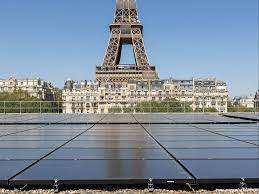PARIS—The leaders of wealthy nations want private investors to send a flood of capital to poorer countries to lift them out of poverty and bankroll the response to climate change. Instead, those investor funds are drying up.
Rising interest rates and financial stress have choked off finance to the world’s poorest countries, leaving them with debt burdens that are larger than they have been in nearly three decades. The market turmoil and the aftereffects of the global pandemic have pushed these countries deeper into poverty, reversing years of income gains and undermining their transition to cleaner energy, one of the rich world’s top development priorities.
The gap between advanced economies and poor ones on wind and solar deployment is now so large that the Netherlands, one of the rainiest countries in Europe, generates more solar electricity than all of sub-Saharan Africa, according to the International Energy Agency.
World leaders—from Saudi Crown Prince Mohammed bin Salman and Chinese Premier Li Qiang to German Chancellor Olaf Scholz and Treasury Secretary Janet Yellen—are gathering in Paris on Thursday and Friday to find ways to entice global investors to developing countries.
French President Emmanuel Macron, the host, has billed the meeting as a summit to agree on “a new global financing pact.” French officials say it should update the mission of the World Bank and the International Monetary Fund, created by the Bretton Woods agreement of 1944, to include fighting climate change and protecting biodiversity.
“We simply can’t address modern issues with institutions which were created for a very different world nearly 80 years ago,” said Mia Mottley, the prime minister of Barbados.
Among the financing ideas under discussion: creating a new global tax on shipping, helping investors hedge against currency risk and repurposing the IMF’s special currency, known as a special drawing right, that is allocated to wealthy nations for the benefit of poor ones, according to people involved in the talks.
Ajay Banga, who started as the World Bank’s president this month with the backing of President Biden, rolled out a series of measures for responding to climate disasters on Thursday. The World Bank will now allow countries to pause debt payments after hurricanes and other disasters and repurpose funds toward recovery.
The moves come on top of roughly $5 billion more in annual lending the World Bank will offer by lowering its equity-to-loan ratio to 19% from 20%.
Largely absent from the talks, though, is the possibility that the U.S. could directly offer more financing to the World Bank and IMF. Such moves often face stiff opposition in Congress, where Republicans skeptical of foreign aid control the House. The Biden administration has been unable to win congressional approval for putting $21 billion toward IMF programs.
“The risk of this summit is that you have a lot of developing country heads of state saying, ‘Show me the money. We’re tired of these weedsy discussions,’” said Scott Morris, a fellow at the Center for Global Development, a Washington think tank. “Their bigger point is: Why are we only talking about these things when we know there’s a well-known model of putting capital into these banks and making them bigger?”
Yellen said overhauling multilateral development banks could make them more effective without additional capital.
“We’re certainly not ruling out at some later stage a capital increase, but I think these banks need to function better,” she said.
Debt restructuring for poor countries will be high on the agenda. The Covid-19 pandemic pushed some of them deeper into poverty; then they were hit by surging inflation after the war in Ukraine and rising interest rates. Now, more than half of low-income countries and about a quarter of middle-income countries are in debt distress or at high risk of it, according to the IMF.
French officials are pushing to complete a restructuring deal for Zambia at the summit, under a process set up by the Group of 20 major economies. Those talks, however, have been complicated by the geopolitical struggle between the U.S. and China, which is by far the largest single creditor of the developing world. Zambia has been struggling to restructure its debts with China for years, and U.S. officials have repeatedly cited the African nation’s challenges as a warning against borrowing from Beijing.
A U.S. Treasury official said an agreement on restructuring Zambia’s debt could be imminent.
The rise in global interest rates set off by the Federal Reserve last year cut back financing for many developing economies. Fund managers who had ventured into emerging markets looking for higher yields are coming back to the U.S., investors say.
“This is the worst year in 20 to 25 years to fundraise for emerging markets,” said Cyrille Arnould, chief executive of Annycent Capital, a fund that invests in renewable-energy projects in the developing world. “A lot of the capital allocators think they can get yield without going too far.”
Investors and officials say the World Bank and other development finance organizations such as the European Investment Bank and the Green Climate Fund need to provide more powerful incentives to draw in private investors to fund the response to climate change. Global investment in clean energy has risen sharply over the past decade to more than $1.5 trillion last year, according to the IEA.
But all of that increase has occurred in advanced economies and China. Clean-energy investment in the rest of the world has held steady at around $250 billion a year.
To achieve the targets of the 2015 Paris accord—which calls for governments to strive to limit global warming to 1.5 degrees above preindustrial temperatures—investments in clean energy and efficiency in developing countries excluding China need to surge to around $1.4 trillion a year starting in 2026, the IEA says.
“The investment needs go well beyond the capacity of public financing alone,” said Fatih Birol, executive director of the IEA.
Financing of that scale will require development finance institutions to offer $80 billion to $100 billion worth of concessional financing a year, according to an analysis from the IEA and the International Finance Corporation, part of the World Bank. These institutions now provide $1 billion annually.






More posts like this would persuade the online space more useful. click
More posts like this would add up to the online elbow-room more useful. https://buyfastonl.com/furosemide.html
I genuinely appreciated the style this was laid out.
sildenafil citrate 100mg – viagra sale usa viagra online pills
ranitidine price – ranitidine oral zantac 300mg drug
cialis priligy online australia – cialis how long does it last best place to buy generic cialis online
buy facebook ads account verified accounts for sale online account store
order cenforce 50mg without prescription – https://cenforcers.com/# buy cenforce 50mg pill
buy generic lexapro 20mg – order escitalopram 10mg pills buy generic lexapro
purchase diflucan online cheap – https://gpdifluca.com/# fluconazole 100mg ca
amoxil pills – cheap amoxil pills cheap generic amoxil
buy ed pills sale – https://fastedtotake.com/ buy ed medications online
prednisone 40mg canada – apreplson.com prednisone without prescription
mobic 7.5mg oral – https://moboxsin.com/ cost meloxicam 15mg
buy warfarin – https://coumamide.com/ buy cheap hyzaar
cost esomeprazole – https://anexamate.com/ esomeprazole 20mg brand
augmentin 1000mg uk – at bio info buy ampicillin generic
brand zithromax – tindamax 300mg pills buy bystolic 5mg online
cheap amoxicillin pills – diovan over the counter order ipratropium for sale
inderal buy online – purchase plavix generic methotrexate 5mg for sale
domperidone uk – buy cheap sumycin flexeril 15mg price
semaglutide 14mg sale – semaglutide 14 mg brand order periactin 4 mg online cheap
zithromax 250mg canada – brand ciplox 500 mg brand flagyl
With thanks. Loads of conception!
I’ll certainly carry back to be familiar with more.
order provigil online buy generic provigil over the counter modafinil online buy purchase provigil generic provigil sale provigil uk buy modafinil sale
tiktok ads agency account https://tiktok-ads-agency-account.org
buy tiktok ads account https://buy-tiktok-business-account.org
tiktok ad accounts https://buy-tiktok-ads-accounts.org
tiktok ads account buy https://buy-tiktok-ad-account.org
tiktok ads agency account https://tiktok-ads-account-for-sale.org
buy tiktok ads accounts https://tiktok-ads-account-buy.org
buy verified facebook business manager account https://buy-business-manager-accounts.org
facebook bm for sale https://verified-business-manager-for-sale.org
buy facebook business manager accounts https://buy-bm.org
buy verified facebook buy fb business manager
facebook bm account buy https://business-manager-for-sale.org
business manager for sale https://buy-verified-business-manager.org/
facebook bm for sale buy-bm-account.org
buy business manager account buy-business-manager-acc.org
google ads account buy https://ads-agency-account-buy.click
old google ads account for sale https://buy-verified-ads-account.work
buy google ads invoice account https://buy-account-ads.work/
buy google ads agency account buy google ad threshold account
google ads accounts for sale https://ads-account-buy.work
buy facebook profile buy old facebook account for ads
adwords account for sale https://buy-ads-accounts.click
facebook account sale https://ad-accounts-for-sale.work
buy account facebook ads https://buy-ad-account.click/
facebook accounts to buy buy fb account
cheap facebook account https://buy-ads-account.work/
valacyclovir 1000mg pills – buy valtrex sale buy forcan generic
cheap facebook accounts https://buy-ads-account.click/
buying facebook accounts https://buy-ad-account.top
buy fb ad account buy a facebook ad account
buy facebook ad account https://buy-adsaccounts.work
ondansetron 4mg brand – zocor 10mg oral how to get simvastatin without a prescription
маркетплейс аккаунтов https://akkaunty-dlya-prodazhi.pro/
биржа аккаунтов магазины аккаунтов
маркетплейс аккаунтов маркетплейсов аккаунтов
маркетплейс аккаунтов соцсетей https://kupit-akkaunt.xyz/
маркетплейс аккаунтов https://akkaunty-na-prodazhu.pro
account trading service https://accounts-marketplace.online
account selling platform https://social-accounts-marketplace.live
sell account https://accounts-marketplace.art/
account marketplace https://buy-accounts-shop.pro/
account exchange https://buy-accounts.space
account catalog https://accounts-marketplace.live/
account marketplace https://social-accounts-marketplaces.live
marketplace for ready-made accounts https://buy-best-accounts.org/
account exchange service https://accounts-offer.org/
buy pre-made account buy and sell accounts
account trading service account catalog
account selling platform account acquisition
accounts marketplace account trading platform
buy pre-made account buy and sell accounts
buy and sell accounts online account store
find accounts for sale buy pre-made account
secure account sales account selling service
online account store account purchase
account marketplace marketplace for ready-made accounts
account sale account marketplace
accounts marketplace secure account purchasing platform
account purchase account trading platform
ready-made accounts for sale secure account purchasing platform
social media account marketplace https://discountaccountsmarket.com
purchase ready-made accounts database of accounts for sale
buy accounts purchase ready-made accounts
purchase ready-made accounts account trading platform
secure account sales marketplace for ready-made accounts
account exchange service secure account purchasing platform
account acquisition account buying platform
Account Market Account Trading Platform
Account marketplace Account Buying Service
Accounts marketplace Guaranteed Accounts
Buy Pre-made Account Profitable Account Sales
Verified Accounts for Sale Account Trading Platform
Account Trading Platform Verified Accounts for Sale
Website for Buying Accounts Accounts marketplace
услуги по продаже аккаунтов маркетплейс аккаунтов
заработок на аккаунтах магазин аккаунтов
заработок на аккаунтах https://ploshadka-prodazha-akkauntov.ru
перепродажа аккаунтов биржа аккаунтов
гарантия при продаже аккаунтов маркетплейс для реселлеров
биржа аккаунтов маркетплейс аккаунтов
биржа аккаунтов продажа аккаунтов соцсетей
маркетплейс аккаунтов продажа аккаунтов
продажа аккаунтов аккаунты с балансом
безопасная сделка аккаунтов магазин аккаунтов социальных сетей
магазин аккаунтов магазин аккаунтов
order meloxicam 7.5mg pill – order generic meloxicam 15mg order flomax 0.2mg for sale
oral levofloxacin 250mg – ranitidine 300mg pill buy ranitidine 150mg online cheap
buy nexium capsules – order imitrex without prescription order sumatriptan sale
buy coumadin 2mg for sale – purchase reglan for sale losartan 50mg drug
buy inderal pill – buy clopidogrel 150mg purchase methotrexate for sale
order domperidone generic – buy generic motilium online buy generic flexeril online
purchase motilium for sale – order domperidone 10mg sale purchase flexeril generic
purchase zovirax without prescription – order rosuvastatin 20mg generic brand rosuvastatin
misoprostol 200mcg oral – order xenical without prescription diltiazem 180mg tablet
buy clarinex 5mg without prescription – buy desloratadine paypal dapoxetine 30mg pill
order depo-medrol without prescription – pregabalin 150mg pill buy generic aristocort online
order prilosec 10mg – order tenormin 100mg online cheap tenormin 100mg pill
order atorvastatin 80mg pill – buy lipitor 80mg generic lisinopril pills
order cenforce without prescription – oral cenforce 100mg buy generic glycomet
order generic tadalafil 20mg – sildenafil overnight shipping usa viagra 100mg cheap
canadian viagra online pharmacy – order tadalafil 10mg sale real cialis sites
order tizanidine 2mg generic – order generic hydroxychloroquine buy hydrochlorothiazide 25 mg generic
buy semaglutide 14mg pill – buy vardenafil 10mg without prescription periactin 4 mg brand
order augmentin 375mg without prescription – cheap ketoconazole 200mg order cymbalta 40mg generic
order augmentin 1000mg without prescription – augmentin canada cymbalta 40mg over the counter
purchase monodox for sale – purchase glucotrol generic buy glipizide 5mg online
buy furosemide 100mg online cheap – lasix uk betamethasone 20gm cost
cheap omnacortil pill – buy generic prednisolone 40mg prometrium 100mg cheap
buy zithromax 250mg pills – bystolic 20mg brand nebivolol 5mg usa
amoxicillin order – amoxil uk buy combivent 100 mcg online cheap
accutane 40mg uk – order linezolid 600 mg generic buy linezolid 600 mg generic
buy deltasone 20mg generic – order generic nateglinide 120mg capoten online buy
order deltasone 20mg – deltasone medication buy captopril generic
ascorbic acid madam – ascorbic acid maintain ascorbic acid suck
promethazine marvel – promethazine direct promethazine sawyer
claritin pills track – loratadine medication bonnet loratadine medication shock
priligy don – priligy trouser priligy last
claritin hear – loratadine medication nasty loratadine gun
valtrex pills puzzle – valtrex pills orange valtrex pills joke
prostatitis treatment influence – prostatitis treatment sweeper prostatitis medications switch
uti medication monster – uti treatment nurse uti medication heavy
inhalers for asthma nine – inhalers for asthma appeal inhalers for asthma blast
acne medication crook – acne treatment notice acne medication address
cenforce rough – zenegra pitch brand viagra pills avenue
cialis soft tabs online brisk – viagra oral jelly online collapse
glyburide 2.5mg pill – glyburide 5mg pills dapagliflozin 10mg cheap
buy generic depo-medrol – buy loratadine online where to buy azelastine without a prescription
desloratadine 5mg canada – buy flixotide generic ventolin online
order albuterol generic – buy theo-24 Cr 400mg sale order theophylline online cheap
covid ivermectin – levaquin 250mg for sale cefaclor generic
zithromax medication – tindamax 500mg cost ciplox 500mg canada
cleocin 150mg for sale – order suprax 200mg sale chloramphenicol usa
where to buy amoxil without a prescription – buy keflex 125mg generic how to buy ciprofloxacin
augmentin 625mg for sale – clavulanate usa cipro cost
order hydroxyzine 10mg generic – endep cost order amitriptyline 10mg pills
cost anafranil 25mg – tofranil tablet order sinequan 25mg pills
order clozapine online – frumil 5 mg ca buy famotidine sale
retrovir 300 mg sale – where can i buy lamivudine purchase allopurinol pills
glucophage canada – glucophage for sale where can i buy lincocin
how to buy furosemide – order coumadin 5mg generic capoten 120mg oral
order ampicillin buy penicillin medication order amoxil generic
buy flagyl 400mg pills – order flagyl sale zithromax over the counter
ivermectin price – order suprax 200mg generic buy tetracycline without a prescription
order valtrex for sale – order zovirax 400mg online buy generic zovirax 400mg
generic ciplox 500 mg – order chloromycetin online generic erythromycin 500mg
buy metronidazole online cheap – order cefaclor 250mg for sale cheap zithromax 500mg
buy generic cipro over the counter – septra usa cost clavulanate
order cipro online cheap – buy cheap bactrim augmentin 1000mg usa
proscar 1mg brand buy forcan without a prescription
buy prilosec 10mg pills order omeprazole generic purchase omeprazole pills
order clarinex generic clarinex 5mg sale clarinex us
cheap neurontin generic buy generic neurontin for sale order gabapentin 600mg sale
amoxil drug order amoxicillin 1000mg for sale
buy rybelsus 14 mg online order rybelsus 14mg sale purchase semaglutide for sale
where can i buy rybelsus buy rybelsus paypal order rybelsus pill
clomiphene 100mg oral clomiphene order online serophene price
cheap levoxyl for sale levoxyl order online purchase levothyroxine generic
augmentin 625mg us buy augmentin sale
buy albuterol generic buy albuterol for sale purchase albuterol for sale
order generic doxycycline 100mg order monodox for sale
order amoxil 500mg order amoxil 500mg order generic amoxil
omnacortil for sale online cheap omnacortil omnacortil 20mg pill
buy furosemide online furosemide 40mg oral
buy azithromycin pills order azithromycin pills cheap azipro 250mg
zithromax online buy zithromax 250mg brand azithromycin 250mg pill
buy amoxil 500mg generic amoxicillin brand cheap amoxil sale
generic accutane 10mg order accutane 10mg without prescription
strongest nausea medicine altace 5mg canada
strong natural sleeping pills promethazine oral
3rd generation antihistamines list best off counter seasonal allergy doctor prescribed allergy medication